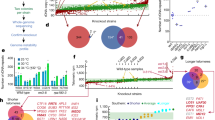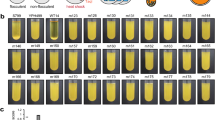Abstract
Identifying the genetic variation underlying quantitative trait loci remains problematic. Consequently, our molecular understanding of genetically complex, quantitative traits is limited. To address this issue directly, we mapped three quantitative trait loci that control yeast sporulation efficiency to single-nucleotide resolution in a noncoding regulatory region (RME1) and to two missense mutations (TAO3 and MKT1). For each quantitative trait locus, the responsible polymorphism is rare among a diverse set of 13 yeast strains, suggestive of genetic heterogeneity in the control of yeast sporulation. Additionally, under optimal conditions, we reconstituted ∼92% of the sporulation efficiency difference between the two genetically distinct parents by engineering three nucleotide changes in the appropriate yeast genome. Our results provide the highest resolution to date of the molecular basis of a quantitative trait, showing that the interaction of a few genetic variants can have a profound phenotypic effect.
This is a preview of subscription content, access via your institution
Access options
Subscribe to this journal
Receive 12 print issues and online access
$209.00 per year
only $17.42 per issue
Buy this article
- Purchase on Springer Link
- Instant access to full article PDF
Prices may be subject to local taxes which are calculated during checkout






Similar content being viewed by others
References
Mackay, T.F. The genetic architecture of quantitative traits. Annu. Rev. Genet. 35, 303–339 (2001).
Glazier, A.M., Nadeau, J.H. & Aitman, T.J. Finding genes that underlie complex traits. Science 298, 2345–2349 (2002).
Page, G.P., George, V., Go, R.C., Page, P.Z. & Allison, D.B. “Are we there yet?”: Deciding when one has demonstrated specific genetic causation in complex diseases and quantitative traits. Am. J. Hum. Genet. 73, 711–719 (2003).
Flint, J. & Mott, R. Finding the molecular basis of quantitative traits: successes and pitfalls. Nat. Rev. Genet. 2, 437–445 (2001).
Risch, N.J. Searching for genetic determinants in the new millennium. Nature 405, 847–856 (2000).
Esposito, R.E. & Klapholz, S. Meiosis and Ascospore Development (Cold Spring Harbor Laboratory, Cold Spring Harbor, New York, 1981).
Winzeler, E.A. et al. Direct allelic variation scanning of the yeast genome. Science 281, 1194–1197 (1998).
Goffeau, A. et al. Life with 6000 genes. Science 274, 546, 563–567 (1996).
Steinmetz, L.M. et al. Dissecting the architecture of a quantitative trait locus in yeast. Nature 416, 326–330 (2002).
Mewes, H.W., Albermann, K., Heumann, K., Liebl, S. & Pfeiffer, F. MIPS: a database for protein sequences, homology data and yeast genome information. Nucleic Acids Res. 25, 28–30 (1997).
Cliften, P. et al. Finding functional features in Saccharomyces genomes by phylogenetic footprinting. Science 301, 71–76 (2003).
Kellis, M., Patterson, N., Endrizzi, M., Birren, B. & Lander, E.S. Sequencing and comparison of yeast species to identify genes and regulatory elements. Nature 423, 241–254 (2003).
Hirschhorn, J.N. & Daly, M.J. Genome-wide association studies for common diseases and complex traits. Nat. Rev. Genet. 6, 95–108 (2005).
The International HapMap Consortium. The International HapMap Project. Nature 426, 789–796 (2003).
Winzeler, E.A. et al. Genetic diversity in yeast assessed with whole-genome oligonucleotide arrays. Genetics 163, 79–89 (2003).
McCusker, J.H., Clemons, K.V., Stevens, D.A. & Davis, R.W. Genetic characterization of pathogenic Saccharomyces cerevisiae isolates. Genetics 136, 1261–1269 (1994).
Carlborg, O. & Haley, C.S. Epistasis: too often neglected in complex trait studies? Nat. Rev. Genet. 5, 618–625 (2004).
Brem, R.B. & Kruglyak, L. The landscape of genetic complexity across 5,700 gene expression traits in yeast. Proc. Natl. Acad. Sci. USA 102, 1572–1577 (2005).
Farrall, M. Quantitative genetic variation: a post-modern view. Hum. Mol. Genet. 13, R1–R7 (2004).
Singer, J.B. et al. Genetic dissection of complex traits with chromosome substitution strains of mice. Science 304, 445–448 (2004).
Tabor, H.K., Risch, N.J. & Myers, R.M. Opinion: Candidate-gene approaches for studying complex genetic traits: practical considerations. Nat. Rev. Genet. 3, 391–397 (2002).
Mitchell, A.P. & Herskowitz, I. Activation of meiosis and sporulation by repression of the RME1 product in yeast. Nature 319, 738–742 (1986).
Du, L.L. & Novick, P. Pag1p, a novel protein associated with protein kinase Cbk1p, is required for cell morphogenesis and proliferation in Saccharomyces cerevisiae. Mol. Biol. Cell 13, 503–514 (2002).
Wickner, R.B. MKT1, a nonessential Saccharomyces cerevisiae gene with a temperature-dependent effect on replication of M2 double-stranded RNA. J. Bacteriol. 169, 4941–4945 (1987).
Tadauchi, T., Inada, T., Matsumoto, K. & Irie, K. Posttranscriptional regulation of HO expression by the Mkt1-Pbp1 complex. Mol. Cell. Biol. 24, 3670–3681 (2004).
Chu, S. et al. The transcriptional program of sporulation in budding yeast. Science 282, 699–705 (1998).
Primig, M. et al. The core meiotic transcriptome in budding yeasts. Nat. Genet. 26, 415–423 (2000).
Briza, P. et al. Systematic analysis of sporulation phenotypes in 624 non-lethal homozygous deletion strains of Saccharomyces cerevisiae. Yeast 19, 403–422 (2002).
Deutschbauer, A.M., Williams, R.M., Chu, A.M. & Davis, R.W. Parallel phenotypic analysis of sporulation and postgermination growth in Saccharomyces cerevisiae. Proc. Natl. Acad. Sci. USA 99, 15530–15535 (2002).
Enyenihi, A.H. & Saunders, W.S. Large-scale functional genomic analysis of sporulation and meiosis in Saccharomyces cerevisiae. Genetics 163, 47–54 (2003).
Brachmann, C.B. et al. Designer deletion strains derived from Saccharomyces cerevisiae S288C: a useful set of strains and plasmids for PCR-mediated gene disruption and other applications. Yeast 14, 115–132 (1998).
Goldstein, A.L. & McCusker, J.H. Three new dominant drug resistance cassettes for gene disruption in Saccharomyces cerevisiae. Yeast 15, 1541–1553 (1999).
Storici, F., Lewis, L.K. & Resnick, M.A. In vivo site-directed mutagenesis using oligonucleotides. Nat. Biotechnol. 19, 773–776 (2001).
Guthrie, C. & Fink, G.R. (eds.). Guide to Yeast Genetics and Molecular and Cell Biology (Academic, San Diego, 1991).
Codon, A.C., Gasent-Ramirez, J.M. & Benitez, T. Factors which affect the frequency of sporulation and tetrad formation in Saccharomyces cerevisiae baker's yeasts. Appl. Environ. Microbiol. 61, 630–638 (1995).
Herskowitz, I. & Jensen, R.E. Putting the HO gene to work: practical uses for mating-type switching. Methods Enzymol. 194, 132–146 (1991).
Rozen, S. & Skaletsky, H. Primer3 on the WWW for general users and for biologist programmers. in Bioinformatics Methods and Protocols: Methods in Molecular Biology (eds. Krawetz, S. & Misener, S.) 365–386 (Humana Press, Totowa, New Jersey, 2000).
Gordon, D., Abajian, C. & Green, P. Consed: a graphical tool for sequence finishing. Genome Res. 8, 195–202 (1998).
Winzeler, E.A. et al. Functional characterization of the S. cerevisiae genome by gene deletion and parallel analysis. Science 285, 901–906 (1999).
Giaever, G. et al. Functional profiling of the Saccharomyces cerevisiae genome. Nature 418, 387–391 (2002).
Gray, M., Kupiec, M. & Honigberg, S.M. Site-specific genomic (SSG) and random domain-localized (RDL) mutagenesis in yeast. BMC Biotechnol. 4, 7 (2004).
Jorgensen, P. et al. High-resolution genetic mapping with ordered arrays of Saccharomyces cerevisiae deletion mutants. Genetics 162, 1091–1099 (2002).
Issel-Tarver, L. et al. Saccharomyces Genome Database. Methods Enzymol. 350, 329–346 (2002).
Acknowledgements
We thank L. David, J. Dean, C. Nislow, G. Giaever, K. Gurley, W. Lee, L. Steinmetz, M. Drmanac and D. Richards for assistance and discussions. This work was supported by a National Human Genome Research Institute grant (to R.W.D.).
Author information
Authors and Affiliations
Corresponding authors
Ethics declarations
Competing interests
The authors declare no competing financial interests.
Supplementary information
Supplementary Fig. 1
Inheritance of congenic strains. (PDF 301 kb)
Supplementary Fig. 2
RME1 allelic exchange. (PDF 186 kb)
Supplementary Fig. 3
TAO3 allelic exchange. (PDF 186 kb)
Supplementary Fig. 4
Phenotyping yeast sporulation efficiency. (PDF 166 kb)
Supplementary Table 1
Strain list. (PDF 119 kb)
Rights and permissions
About this article
Cite this article
Deutschbauer, A., Davis, R. Quantitative trait loci mapped to single-nucleotide resolution in yeast. Nat Genet 37, 1333–1340 (2005). https://doi.org/10.1038/ng1674
Received:
Accepted:
Published:
Issue Date:
DOI: https://doi.org/10.1038/ng1674
This article is cited by
-
The fitness trade-off between growth and stress resistance determines the phenotypic landscape
BMC Biology (2024)
-
From beer to breadboards: yeast as a force for biological innovation
Genome Biology (2024)
-
Identification of novel genes involved in neutral lipid storage by quantitative trait loci analysis of Saccharomyces cerevisiae
BMC Genomics (2021)
-
Molecular and evolutionary processes generating variation in gene expression
Nature Reviews Genetics (2021)
-
SNP-ChIP: a versatile and tag-free method to quantify changes in protein binding across the genome
BMC Genomics (2019)



